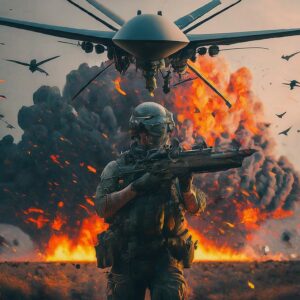
The advent of drone technology has revolutionized modern warfare, transforming the battlefield in ways previously unimaginable. Unmanned Aerial Vehicles (UAVs), commonly known as drones, have become indispensable tools for military operations worldwide.
Their ability to conduct surveillance, gather intelligence, and execute precision strikes has made them a critical asset in contemporary military strategy. This article delves into how drones are changing modern warfare, their efficiency, firepower, and range, providing a comprehensive overview of their impact on military operations.
The Role of Drones in Modern Warfare
One of the primary roles of drones in modern warfare is surveillance and reconnaissance. Equipped with high-resolution cameras, infrared sensors, and advanced radar systems, drones can provide real-time intelligence to military commanders.
This capability allows for better situational awareness, enabling forces to make informed decisions quickly. For instance, drones can monitor enemy movements, identify potential threats, and assess damage after an attack, all without putting human lives at risk.
Target Acquisition and Precision Strikes
Drones have significantly enhanced the precision of military strikes. Armed with guided missiles and bombs, drones can engage targets with remarkable accuracy. This precision minimizes collateral damage and reduces the risk to civilian lives, a critical consideration in modern conflict zones. The ability to loiter over a target area for extended periods allows drones to strike at the most opportune moment, further increasing their effectiveness.
Electronic Warfare and Communication

In addition to their offensive capabilities, drones play a vital role in electronic warfare and communication.
They can jam enemy communications, disrupt radar systems, and provide secure communication links for friendly forces.
This versatility makes drones a valuable asset in both offensive and defensive operations.
Cost-Effectiveness
One of the most significant advantages of drones is their cost-effectiveness. Compared to manned aircraft, drones are relatively inexpensive to produce and maintain. This affordability allows militaries to deploy large numbers of drones, providing extensive coverage and redundancy. Additionally, the lower operational costs make drones an attractive option for prolonged missions.
Reduced Risk to Human Life
Drones eliminate the need for a human pilot, reducing the risk to human life in combat situations. This advantage is particularly crucial in high-risk missions, such as those involving enemy air defenses or hazardous environments. By removing the human element, drones can undertake missions that would be too dangerous for manned aircraft.
Extended Operational Capabilities
Drones can operate for extended periods, far surpassing the endurance of manned aircraft. Some drones can stay airborne for over 24 hours, providing continuous surveillance and support. This extended operational capability is invaluable for missions that require persistent monitoring or long-range reconnaissance.
Rapid Deployment and Flexibility
Drones can be rapidly deployed and are highly flexible in their operations. They can be launched from various platforms, including ships, trucks, and even submarines. This flexibility allows for quick response to emerging threats and the ability to adapt to changing battlefield conditions.
Firepower
The firepower of military drones varies depending on their size and intended role. Here are some examples of the firepower capabilities of different types of drones:
- MQ-9 Reaper: One of the most well-known armed drones, the MQ-9 Reaper, can carry a variety of munitions, including Hellfire missiles, GBU-12 Paveway II laser-guided bombs, and GBU-38 Joint Direct Attack Munitions (JDAM). The Reaper’s payload capacity allows it to engage multiple targets in a single mission.
- Bayraktar TB2: This Turkish drone has gained prominence for its effectiveness in various conflict zones. It can carry up to four MAM-L or MAM-C smart micro munitions, which are designed for precision strikes against armored vehicles and fortified positions.
- Harop: An Israeli loitering munition, the Harop is designed to seek out and destroy enemy radar systems. It carries a high-explosive warhead and can loiter over the battlefield for extended periods before striking its target.
Range
The range of military drones also varies widely, depending on their design and purpose. Here are some examples of the range capabilities of different types of drones:
- Global Hawk: The RQ-4 Global Hawk is a high-altitude, long-endurance (HALE) drone capable of flying over 12,000 nautical miles. It is primarily used for surveillance and reconnaissance missions, providing extensive coverage of large areas.
- Predator: The MQ-1 Predator, one of the earliest armed drones, has a range of approximately 770 miles. It is used for both surveillance and strike missions, offering a balance between endurance and firepower.
- Heron TP: The Heron TP, also known as the Eitan, is an Israeli drone with a range of over 4,500 miles. It is used for long-range reconnaissance and strike missions, capable of carrying a variety of payloads.
The War on Terror
Drones have played a pivotal role in the War on Terror, particularly in regions like Afghanistan, Pakistan, and Yemen. The ability to conduct precision strikes against high-value targets has made drones a key component of counter terrorism operations. For example, the elimination of high-profile terrorist leaders, such as Osama bin Laden’s successor, Ayman al-Zawahiri, was made possible through the use of drones.
The Ukraine Conflict
In the ongoing conflict between Ukraine and Russian-backed separatists, drones have been used extensively for reconnaissance and artillery targeting. Both sides have employed a variety of drones, from small quadcopters to larger, more sophisticated UAVs. The use of drones has provided valuable intelligence and improved the accuracy of artillery strikes, underscoring their importance in modern warfare.
Ethical and Legal Considerations
While drones offer numerous advantages, their use in warfare raises ethical and legal concerns. The ability to conduct remote strikes can lead to questions about accountability and the potential for misuse. Civilian casualties resulting from drone strikes have sparked debates about the ethical implications of their use. Additionally, the proliferation of drone technology raises concerns about its potential use by non-state actors and terrorist organizations.
Future Trends and Developments
The future of drone technology in warfare is likely to see continued advancements in several areas:
- Autonomy: The development of autonomous drones capable of making decisions without human intervention is a significant area of research. These drones could operate in swarms, coordinating their actions to overwhelm enemy defenses.
- Stealth: Advances in stealth technology will make drones harder to detect and intercept. This capability will be particularly valuable in contested airspace.
- Artificial Intelligence: The integration of artificial intelligence (AI) will enhance the capabilities of drones, allowing them to analyze vast amounts of data and identify targets with greater accuracy.
- Counter-Drone Technology: As drones become more prevalent, so too will the development of counter-drone technologies






